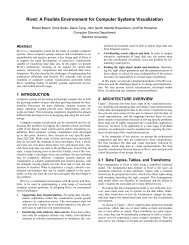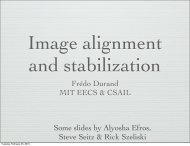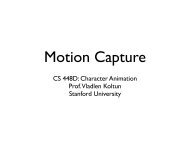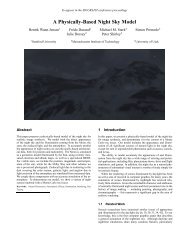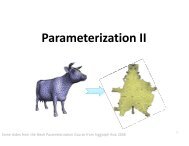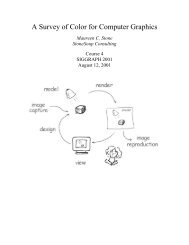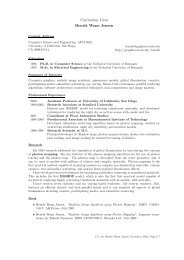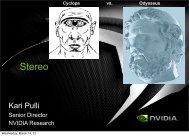Curved Folding - Computer Graphics Laboratory
Curved Folding - Computer Graphics Laboratory
Curved Folding - Computer Graphics Laboratory
Create successful ePaper yourself
Turn your PDF publications into a flip-book with our unique Google optimized e-Paper software.
point p until the surface normals in the end points deviate from the<br />
normal np in p more than a pre-defined threshold. Rulings are also<br />
terminated if they come close to feature lines or boundaries. For<br />
purposes of later pruning, we assign the negative mean deviation of<br />
surface normals along the ruling from np as a measure of quality<br />
to each extended ruling.<br />
Stage C: The set of rulings obtained so far is thinned out while<br />
retaining rulings with high quality measure. We use a greedy approach:<br />
The ruling with highest quality measure is retained, and the<br />
ones intersecting a narrow band around it are removed. Here it is<br />
important to find the right measure of proximity of rulings, because<br />
the surface may exhibit conical parts where rulings intersect at a<br />
common vertex. Thus our band is shorter than the ruling and centered<br />
in its midpoint (in Figure 12 (B+C) these bands are marked<br />
in red and slightly widened for better visibility). All other rulings<br />
which intersect this band are considered ‘close’ and are removed.<br />
We continue the process of pruning until we get a set of (roughly)<br />
evenly spaced rulings on the surface. Regions marked as planar are<br />
confirmed to be planar if they are bounded by three or more rulings<br />
or boundary edges.<br />
Quad dominant decomposition of P . After estimating and<br />
pruning the rulings, we now deal with initializing the planar development<br />
P of D.<br />
We use the development mapping κ to map the estimated ruling directions<br />
from the surface D to the plane. From this set of mapped<br />
rulings, we generate a coarse quad-dominant mesh P . Note that<br />
here a correct connectivity is much more important than the actual<br />
coordinates of the vertices. Subsequent optimization retains<br />
the connectivity of the initial mesh while updating the vertex positions.<br />
The available input data for mesh generation are the estimated rulings<br />
mapped to the plane, the boundary of the planar mesh κ(D),<br />
and the location of ridge lines in the original surface, which are<br />
used as candidate curved fold locations (see Figure 13, left). First,<br />
all end points of rulings are snapped to the closest boundary or<br />
ridge line — or, if the latter are too far away, are clustered in a<br />
point. Additionally short ridge lines are contracted to a single cone<br />
point (see Figure 13, center). Depending on the snapping target,<br />
we roughly classify an endpoint as boundary point, fold point, or<br />
cone point, respectively. In our examples, we frequently encountered<br />
combinations of two of these (e.g. a curved fold might extend<br />
to the boundary). The extension of rulings to boundary and ridge<br />
lines might introduce intersections close to ruling end points. Such<br />
intersections are resolved by swapping the corresponding end point<br />
vertex coordinates. We get a preliminary mesh by connecting ruling<br />
end points as they are traversed along the boundary and ridge<br />
lines, generating mostly long quadrilateral faces.<br />
Figure 13: Initial mesh layout. Left: A given collection of rulings<br />
(blue), ridge lines (brown), and mesh boundaries (gray). Center:<br />
Ruling endpoints are snapped and classified as boundary points<br />
(gray), fold points (blue) and cone points (brown). Right: By inserting<br />
and deleting rulings, a valid mesh connectivity without Tjunctions<br />
is obtained. The planar parts of the original shape are<br />
marked in yellow.<br />
The resulting mesh is next modified by deleting or inserting rulings<br />
based on the following observations: (i) From any point on a fold,<br />
two rulings must emanate to prevent any T-junctions on the fold.<br />
(ii) Planar regions must be bounded either by rulings or a boundary<br />
curve. (iii) Boundary corner points should be included to preserve<br />
the shape of the base mesh. (iv) Faces adjacent to cone points might<br />
have more than four vertices. To ensure an optimal approximation<br />
of these regions, such faces need to be split into triangles or quads<br />
for our subdivision stage to apply. If a face holds more than a single<br />
cone point and the connecting lines lie entirely in the face, rulings<br />
are inserted connecting the cone points. If necessary, the faces originating<br />
from this step are further split by inserting rulings emanating<br />
from cone points. Finally, we obtain a quad dominant planar<br />
mesh P (see Figure 13, right).<br />
Initialization of the polygon soup M. Initialization of our optimization<br />
procedure is complete when a polygon soup M, corresponding<br />
to the development P and close to the original shape D,<br />
is found. We find a face M i of M corresponding to a face P i of P<br />
by applying κ − 1 to the vertices of P i . Since the resulting vertices,<br />
in general, do not form a planar polygon which is isometric to P i ,<br />
we register a copy of P i to these mapped vertices to initialize M i .<br />
Now we can apply the optimization alogrithm of Section 3 and obtain<br />
a mesh which approximates the given data D and has the optimized<br />
version of P as its precise development. In order to efficiently<br />
achieve high approximation quality, we start with a coarse<br />
approximation which is subsequently refined (by splitting quads in<br />
ruling direction) and optimized again. Results are shown in Figures<br />
1, 2, 7, 14 and 16.<br />
6 Further applications and discussion<br />
As illustrated by Figure 14, surface reconstruction can nicely be<br />
combined with deformation tools such as [Kilian et al. 2007]. We<br />
first compute a digital reconstruction of a physical model and then<br />
vary its shape by an as-isometric-as possible deformation. The deformation<br />
will introduce deviations from a true developable surface,<br />
but it turns out that our reconstruction works very well on such deformed<br />
data sets. Note that even precisely isometric deformations<br />
in general do not preserve rulings and therefore rulings have to be<br />
re-estimated. In the example of Figure 14 it turned out that the optimization<br />
worked well with the initialization for the reconstruction<br />
of the physical model. In other cases, one may have to re-initialize<br />
for intermediate positions in a deformation sequence.<br />
We emphasize here that the design and reconstruction of objects<br />
with curved folds is not simply solvable by a parameterization<br />
method. Parameterization will not yield any information about the<br />
precise location of folds, rulings and types of ruled patches, nor will<br />
it modify a data set to become precisely developable.<br />
The nature of curved folds. Digital reconstruction of physical<br />
paper models yields a segmentation into torsal ruled patches. This<br />
provides insight into the typical behavior of a developable surface<br />
near curved folds. Some frequently occurring situations are depicted<br />
in Figure 2. In this way, our work can further contribute<br />
both to the theory of curved folding and to applications, e.g., to the<br />
development of interactive CAD tools for modeling objects with<br />
curved folds.<br />
Architectural freeform structures. Developable surfaces are<br />
prominently visible in architectural design [Shelden 2002; Glaeser<br />
and Gruber 2007; Pottmann et al. 2007]. In particular, Frank O.<br />
Gehry has been using these surfaces quite extensively. The presence<br />
of rulings simplifies the actual construction. Panelization, e.g.




